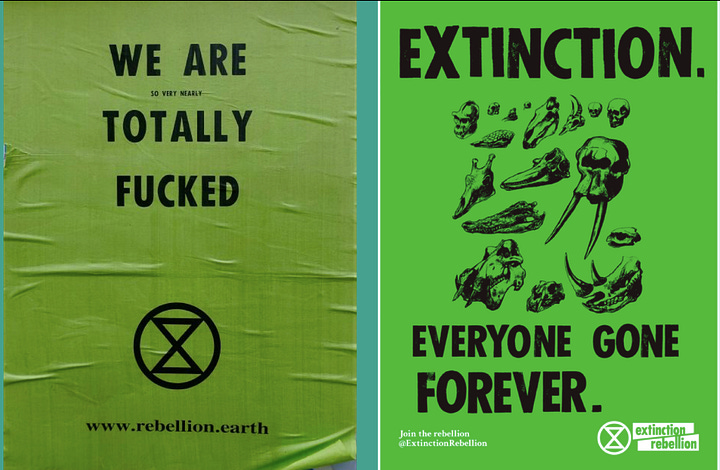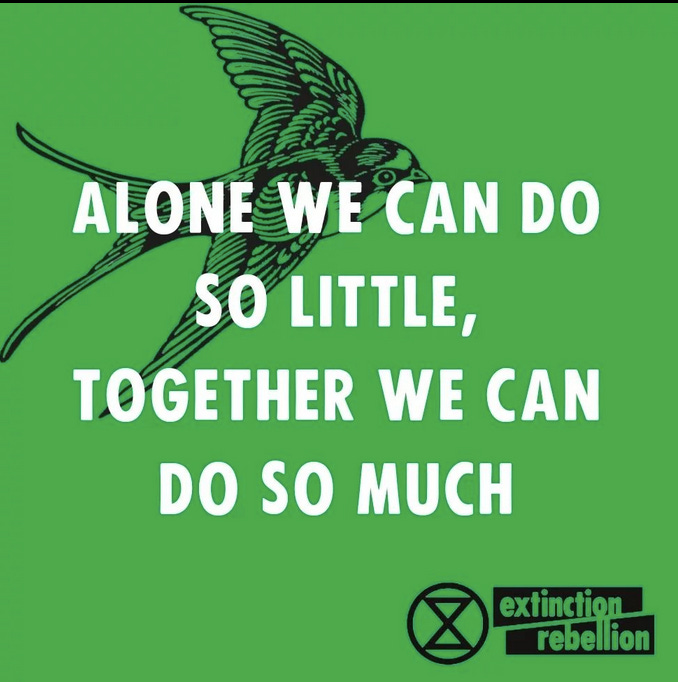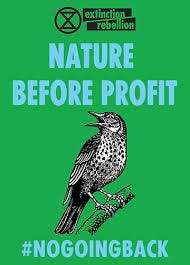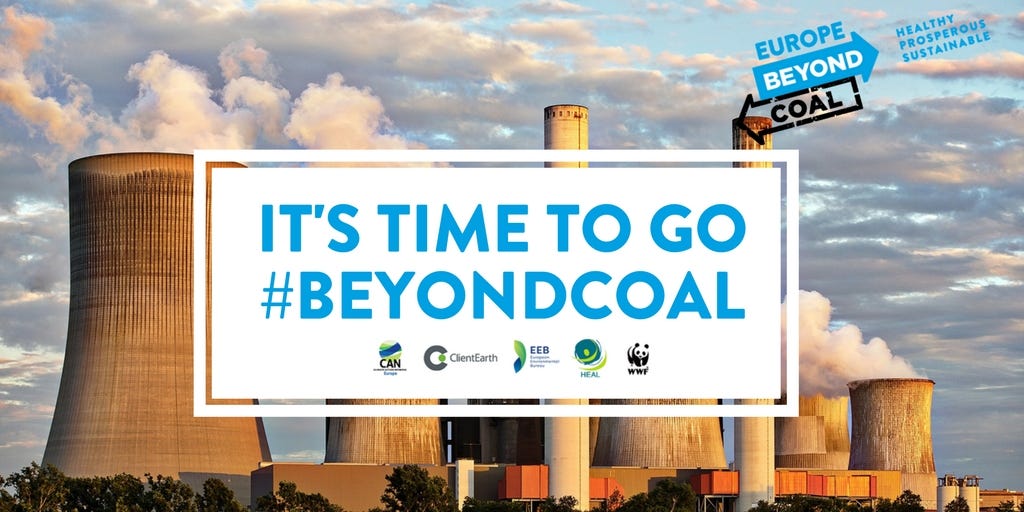I am often asked how I would communicate about climate change, so here goes. We will start with five practical tips for anyone already preparing their #EarthDay comms from hope-based communicator Camila Chaudron. Why are we writing about Earth Day in February not April? Cecause we want to service the movement with guidance to use as you prepare your content.
Then I will do a deep dive making the case for hope in climate comms. I am not a subject expert, I am bringing an outsider perspective. I also don’t claim to speak for the communities already most affected by climate change - I am mainly thinking about how to reach audiences in my own, European, context. I invite you to see how you might apply them differently in your own context.
If you find it useful, please share the post with any climate communicators you know.
Guest piece: Five ways to talk more hopefully about climate change
A hope-based guide for communicating about climate change before, during and after Earth Day - by Camila Chaudron
Messages about climate change are increasingly fearful and sometimes downright apocalyptic. Earth Day is an opportunity to remind us what we are working for – not just avoiding crises, but creating futures for our shared Planet A.
Here are five narrative shifts to communicate hope for the climate:
1. Create an environment for hope (rather than fear)
The systemic changes needed to sustain vibrant communities on Earth are achievable. But to make them a reality, we need to show that this change is possible.
Climate activists can take inspiration from an emerging literary genre called Solarpunk. It imagines futures based on the premise that we make good choices for the environment in the present. Whereas cyberpunk gave us the dystopian futures of Blade Runner, Mad Max and the Matrix, Solarpunk offers us more appealing visions of a world that is ecologically sustainable and ethically responsible.

“Solarpunk protagonists hack power grids to provide free energy to the poor, build intersectional unions to defend against the agents of the matrix, and lead the way into space for the betterment of all peoples - not the stockholders.” - Odin Halvoroson.
Regardless of whether or not your NGO advocates for policy solutions or bright green environmentalism, your campaign should articulate proposals to evoke tangible change. Show people the desirability of change, as well as the urgent need for it to happen.
“If we’re going to cancel the apocalypsewe have to make some meaningful proposals of what we should do.” - Solarpunk author Andrew Hudson.
2) Mobilize for action, with values (rather than against crisis)
Humans are goal-oriented beings, meaning our behaviour is motivated by pursuring and realising objectives. Our brain is an advnaced reward systems that uses chemicals like dopamine to reinforce habits and behaviour.
So give our goal-driven brains something to stand for - like clean air - not just a looming threat to avoid.
Climate comms has for decades made a sober - and sobering - case for action based on statistics and threats: why not try to activate underlying values to connect to and motivate people: for example, work toward clean water regulations because we value health and integrity in our community.
Positive, inclusive and peaceful language like “clean” and “let’s” is easier for stakeholders like policymakers, businesses and citizens to support than negative, unspecific and combative language like “(un)polluted” or “fight.” The Sierra Club’s recent Beyond Carbon campaign proposes a 3-step roadmap to move toward clean power together.
Sensory stimuli can also help. Heartwired to Love the Ocean’s guide, for example, recommends that we incorporate sensory details – the smell of the sea, or the peacefulness of the beach – in addition to values-based mindsets to reach people on a neurological level through our campaigns.
These Heartwired insights are so important for all social change communicators. Your words will only resonate with audiences if they trigger powerful experiences from their own lives. We have to invest our messaging with meaning by connecting to vales and experience.
3) Focus on solutions (not problems) and abundance (over scarcity)
Earth day is a moment to try to create an abundance frame. Can you talk about biodiversity gain that could be achieved, rather than biodiversity loss that will result from failing to act? While on its own only a small part of the solution, talking about the simple value of planting trees can mobilize and inspire the support you need for bigger asks.
“Abundance is a paradigm that breaks people out the zero-sum thinking that makes poverty and deprivation seem unavoidable.” - Andrew Hudson, Solarpunk author
Most people are very well aware of the problems and the existential threat posed by climate change, but the danger of too much urgency is a paralyzing despondency trap. Climate communicators should pivot away from scarcity frames toward abundance.
Filmmaker Damon Gameau’s film 2040 visualizes “what the world could look like that year if we put into practice some of the best solutions that exist today.”
4) Offer an opportunity to be part of something bigger
When presented with opportunities, we have seeds for the future. Threats elicit a flight or fight response, opportunity excites us into action.
EarthJustice tells specific, motivating stories of people changing like Californians Want to Stop Burning Gas in their Homes, using , imagery showing how they win, and offer uplifting rather than apocalyptic visions of the Earth because they focus on people within their environment.
Within your campaign’s design for a sustainable future, what should everyone in your community be doing for each other? And get personal: explain what is in it for me, my friends, family and neighbors? Perhaps people are walking to work, or we are only buying local and seasonal foods at the marketplace.
The more we can get excited about these steps, and the more identifiable and tangible they feel, the more likely we are to engage seriously in the ideas. Just like in a Solarpunk novel or illustration, visualizing this world can help us understand the prosocial behaviors or policies that we need to get there.
5) Create a new in-group - humanity
Human beings have evolved to function in groups. When our brains process information, they are motivated less by a quest for pure knowledge then by the desire to fit in with our in-group by holding the same views (this is called motivated reasoning - see Ezra Klein’s Why we are polarized on this).
So think about the identities that will make use better stewards of our planet. As this World Wildlife campaign beautifully shows, we are all wildlife. It is nearly five years old now, but timeless because it appeals to our innate desire to live in harmony with nature.
Show stories about people who are already changing their lifestyles that encourage us to follow in their footsteps. Conservation International’s incredible video series Women on a Mission, for example, highlights creative and local responses to global environmental issues.
Maybe your NGO doesn’t have the bandwidth or budget for a high-production video – that’s ok.
Voices of Youth compiled a blog with examples of young people around the globe who act locally. Today everyone is a content creator – increasingly, what counts is less production value, but the message.
Stories of everyday people, not just radical revolutionaries, making a tangible difference inspires behavioral change and mindset shifts. In other words, stories for life.
At the end of the day, the most powerful argument for climate action is the most simple, we are all living beings sharing this planet. Maybe we should spend more time reminding people of that?
The case for hope in climate communications
Now that we have shown “how” to do hope-based climate comms, here is some of the “why” climate comms should be based on your hopes, not your fears.
Shift 1. Fear to Hope
Hope is action
I hear people on the need for urgency. But when I hear people say we need more urgency and more outrage I have to ask: How much is enough? What level of urgency and outrage will get us there? Is it that not enough people feel the urgency? Or that the people who currently feel urgency need to show more of it?
Ask yourself: what other emotions do you want associated with that sense of urgency? Determination, perhaps? The danger of constant urgency is that it is constantly activating our brain’s fear response mechanism - something that has evolved to deal with immediate danger, not constant stress and anxiety.
In other words, constant urgency, when it has no immediate constructive outlet for the audience to act upon, can become dis-empowering and paralyzing.
IF we are doomed, why bother acting?




The other problem with fear-based climate communications is that fear triggers a self-interest mindset. When you are in danger, your instinct is to protect yourself and your loved ones. It makes you think short-term. But climate action is inherently long-term in nature.
Fear-based climate messaging faces multiple pitfalls: If we tell people that they are polluting out of greed and selfishness, we may reinforce greed and selfishness. If we say they are causing harm to others (“climate change hits the poorest, hardest”), they may think it does not affect them. If we try to make them focus on their own self-interest (“you will also face climate threats”), we reinforce self-interest.
Better then to focus on messages most likely to lead to the action we want to see. That is where hope comes in.
Hope is goal-oriented thinking. I also often see climate circles confuse the words “hope” and “optimism”. Optimism means thinking things will work out for the best. Hope means believing that we can achieve change if we take action. As Greta Thunberg says, “Hope is action”.


Psychologists agree with her: the science shows that human action is more sustainably motivated by hope than by fear. The psychologist C.R. Snyder talks about hope as a cognitive function made up of goal, pathway and agency - which brings us to…
Shift 2. Problem to solution
Offer alternatives
People know there is a problem. What they need to know is that there is an alternative.
In her climate change book, This Changes Everything, Naomi Klein wrote about how powerful the example of Nordic countries embracing renewable energy was - and how threatening to fossil fuels- because it showed that there is another way to power our societies:
“There is no more potent weapon in the battle against fossil fuels than the creation of real alternatives…Just the glimpse of another kind of economy can be enough to energize the fight against the old one.”
Hope-based climate communications would focus on making people believe that a greener future is possible and desirable and showing them how they can act to achieve it. This is about building up determination to change.
Climate change communications is at its strongest when it shows us alternatives we can believe in: clean streets, clean air, more nature. Things people can get behind.
Above all, show us an aesthetically pleasing, exciting future we can see ourselves in.
“As long as change is identified with a minus sign, its opponents will outnumber its proponents.” - Giuliano da Empoli for More in Common
When our communications is focused on the problem, it starts to feel inevitable, the reference point for how things are. I remember Anat Shenker-Osorio saying that when all you talk about is coal, people start to overestimate the weight of coal mining in the economy. Instead of talking about coal, talk about solar - or whatever else you want instead.

Instead of protesting about the problems, we should be pushing for very specific solutions. One at a time. Not complex treaties: exciting ideas that you can rally a movement around, and pressure leaders to say yes or no to. It is easy for leaders and companies to prevaricate when negotiating complex treaties, but not when you ask them to take a very concrete, practical step.
The best example of this is the Green New Deal: a bold, concrete call to action accompanied by an inspiring vision of the future goal, and a clear narration of the pathway towards it. And the more people attacked it, the higher up the agenda it rose, becoming a policy priority beyond the country in which it was first proposed.
Talk about your solution all the time. If people criticize it: good, that means you are setting the agenda. Every time the climate conversation is about vandalism or blockades, it is a conversation that distracts from the solutions we want.
Right now, it feels like the only relationship we can have with the planet is an extractive one. We need to see that there are other ways of being - we can nurture, safeguard and maintain as well. But if all we talk about is the former, the latter will never get the attention it deserves.
I get the fear: if we show a solution, people will become complacent. But human beings are goal-oriented and reward-driven. If you show them something good happening, they will want more of it.
Shift 3. From against to for
A sense of abundance drives a sense of (common) purpose
Climate communicators should think about the values and underlying ways of thinking about how the world works that will support their cause.
At a basic level, this means creating a sense of abundance (“we are blessed to live on this wonderful, diverse planet and we must respectful find ways to live together that safeguard it”) rather than scarcity (“we are running out of xyz” - which is a cue to hoard and extract the last of it as fast as possible before someone else does).
The work of Common Cause is vital here: they show how different causes such as climate, disability rights or LGBTQ+ rights are all underpinned by a shared set of intrinsic, compassionate, universal and benevolent values. This means that communications for, say, equal marriage, may actually help climate change work.
Some of those values are obvious, like connection to nature. Others are more subtle but equally important, like interdependence, shared humanity.
There are other ways to communicate to people then showing problems and solutions: you can try to reinforce a way of thinking that prepares people to act and think differently.
All social change movements need to work together to build viable alternatives to the dominant ways of thinking in our society: from a capitalistic “survival of the fittest” mindset where individuals and nations are competing for scarce resources to a “nurture is nature” mindset that highlights our instinct to live together in groups, to care for each other and the symbiotic relationships that exist.
Our worldviews matter because they influence our behaviour. If we believe that our fellow humans are fundamentally selfish, then it encourages us to also think of number one.
In The Nutmeg’s Curse, Amitav Ghosh describes the necessity of a shift in worldview away from self-interest, extrinsic values towards intrinsic, compassionate, common interest values needed - particularly when Global South countries could be quite justified in asking why they shouldn’t use fossil fuels to achieve long-denied prosperity:
“Because the conception of wealth that underlies this framing of justice and equity is fundamentally mimetic: “Until I have what the Other has, I am poor:; or “Not till I have what the Other has will justice be served.” It follows then that this conception of wealth is founded on the Other’s conception of the Good Life, as a standard to be aspired to. Hence, if the Other’s conception of the Good Life were to change, then the resonances would be felt everywhere.
“In this lies the importance of Occupy, and Extinction Rebellion, and documents like Pope Francis’s encyclical fratelli tutti: embedded in them all is a radically different conception of the Good Life.”
Ghosh here show the greatest power activists have: not our ability to shout loud about the problem and to make moral judgements; but rather our ability to bring about deep changes in culture and thinking. As Rebecca Solnit says:
“Violence is the power of the state; imagination and non-violence the power of civil society.”
Shift 4. Threat to Opportunity
Show what climate justice actually looks like
Making our values more salient can win new allies. All audiences have both intrinsic and extrinsic values. Climate communications should focus on activating the intrinsic in order to neutralise the extrinsic, materialist ones.
In the context of intrinsic/extrinsic values, Just Stop Oil protests targeting art museums are in the wrong value zone: they are destructive rather than creative
The Common Cause model suggests that love of art and culture is an intrinsic value that can also reinforce love of and connection to nature. So attacking art Undermines the values needed to rally lasting change.
Art should be an ally - it can foster precisely the intrinsic, empowering and uniting values needed to sustain deep and lasting change.

While I understand their motives and commiserate with their frustration, JSO protests are destructive - it is asking people who love art to choose sides when really the message should be “we can work together to make things better for everyone”.
This raises a wider question: what does it look like to be part of the climate movement?
From the perspective of an apolitical person, right now you either have to be an extremely advanced expert in a suit (CoP) or a very radical protestor ready to get arrested (JSO).
But we need more people than that. Indeed, we need almost all of humanity on board for this effort.
Creating conflict and guilt is not going to create the systematic change we need.
Shaming individuals for their climate failure has become deeply embedded in society, even though the personal responsibility narrative is a distraction from the biggest polluters.
Climate communicators should ask “What actions can people take that reinforce sense of agency and belonging to a wider cause?”
The value added of activism should be CHANNELING the legitimate grief and anger we feel into constructive action.
Shift 5 Victim to human
Tell stories of change
The stories we tell about climate change must grow beyond protests and summits, and beyond disasters and polluters. Away from villains and victims to human beings working together to do things differently.
Amitav Ghosh writes about the danger of climate change becoming a niche field of expertise, removed from human experience:
“The subject of climate change has come to be enclosed within a vast palisade of scientific and academic expertise: indeed, the very phrase “climate change” has come to refer not just to a process that is unfolding in the world, but also to a highly specialized field of knowledge…
“Climate change is a much vaster phenomenon that the economy, yet the voices and perspectives of those who are affected by it - farmers, fisherfolk, migrants, and so on - very rarely figure in the discussion. And when they do, it is usually merely as victims, whose voices fill the blanks in a script that has already been written by specialists.”
So, who should be at the heart of the climate story? The climate movement needs to be about all of us. Actual human beings starting to live the lifestyle that we all need to adopt.
Greta Thunberg is at her most powerful (and she is almost always powerful!), and most triggering for ant-climate folk, when she lives her values, for example by sailing across the Atlantic to the UN, demonstrating how we can all travel more sustainably.
What you do is the narrative: stunts do not actually direct attention to the climate crisis but to the people carrying out the stunts. And they certainly do not direct attention to the profound changes needed in the way our society operates.
What will direct attention to those changes? Carrying out those changes. What will increase the impact of those small changes? Talking about them more.
That is the difference: traditional communications raises awareness, strategic communications changes awareness.
hopey, changey stuff
Some hope-based climate reading
Initiatives bringing new climate narratives to life: Stories for life and, from Fine Acts, Team Earth and the Artists for Climate.
Great climate messaging in Grist: The first article that alerted me to the importance of hope and framing
It’s time to change the climate disaster script. People need hope that things can change, oped by narrative expert Nicky Hawkins (and another from Rebecca Solnit).
UK framing group PIRC lead the way on climate messaging: check out their framing nature and climate justice messaging guides.
The Endless Sea: Imagining a Story of Tomorrow is a brilliant essay Giulani de Empoli wrote for More in Common.
I hope you find this guidance useful. If you have questions or doubts, something you are still processing, or have had a profound “aha” moment, please share!








